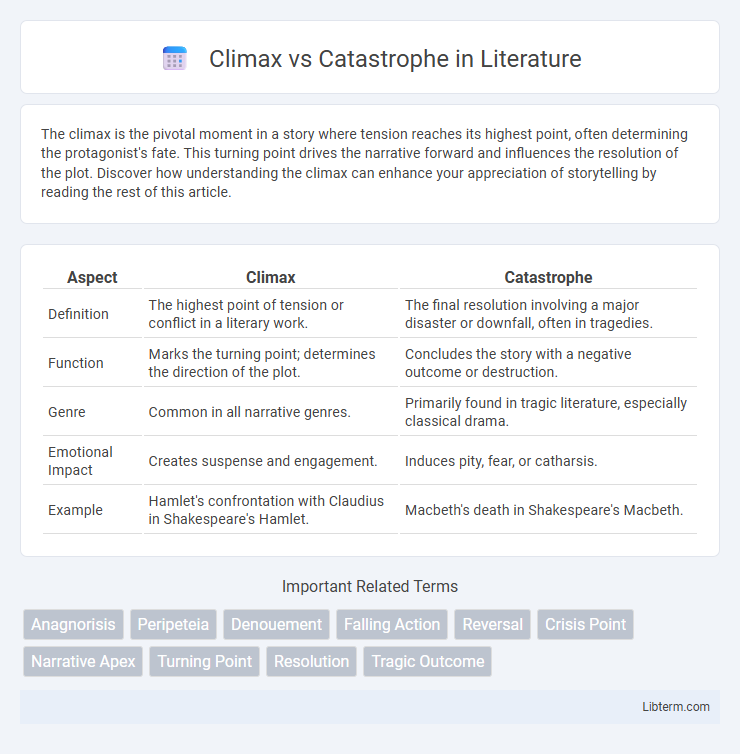The climax is the pivotal moment in a story where tension reaches its highest point, often determining the protagonist's fate. This turning point drives the narrative forward and influences the resolution of the plot. Discover how understanding the climax can enhance your appreciation of storytelling by reading the rest of this article.
Table of Comparison
| Aspect | Climax | Catastrophe |
|---|---|---|
| Definition | The highest point of tension or conflict in a literary work. | The final resolution involving a major disaster or downfall, often in tragedies. |
| Function | Marks the turning point; determines the direction of the plot. | Concludes the story with a negative outcome or destruction. |
| Genre | Common in all narrative genres. | Primarily found in tragic literature, especially classical drama. |
| Emotional Impact | Creates suspense and engagement. | Induces pity, fear, or catharsis. |
| Example | Hamlet's confrontation with Claudius in Shakespeare's Hamlet. | Macbeth's death in Shakespeare's Macbeth. |
Understanding Climax and Catastrophe
Climax represents the peak of tension or conflict in a narrative, where the protagonist faces their greatest challenge, resulting in a turning point for the story's outcome. Catastrophe follows the climax, typically marking the resolution in tragedies, where the consequences lead to a downfall or significant loss for the protagonist. Understanding the distinction between climax and catastrophe clarifies how narratives build emotional intensity and deliver impactful conclusions.
Defining Climax in Literature
The climax in literature represents the moment of highest tension or conflict, where the protagonist faces the most significant challenge or decision. This pivotal scene drives the narrative towards resolution, revealing key character motivations and propelling the story's emotional intensity. Distinct from the catastrophe, which typically denotes the tragic downfall or final outcome, the climax serves as the turning point that determines the story's direction.
Defining Catastrophe in Storytelling
Catastrophe in storytelling marks the devastating final event that concludes the narrative's conflict, often leading to the protagonist's downfall or irreversible loss. It serves as the emotional and plot resolution following the climax, highlighting the consequences of prior actions and decisions. This moment solidifies the story's thematic message by portraying the ultimate price of the central conflict.
Structural Roles in Narrative Arc
The climax serves as the peak of tension and emotional intensity in a narrative arc, where the main conflict reaches its turning point, driving the story toward resolution. The catastrophe follows the climax, typically in tragedies, marking the downfall or complete unraveling of the protagonist's circumstances, leading to the narrative's final consequences. Structurally, the climax acts as the pivotal moment that determines the direction of the plot, while the catastrophe provides closure by illustrating the aftermath of the protagonist's critical decisions or actions.
Emotional Impact on Audience
The climax generates intense emotional engagement by reaching the story's highest point of tension, compelling the audience to invest deeply in the characters' outcomes. In contrast, the catastrophe delivers a powerful emotional release through tragic resolution or downfall, often evoking feelings of sorrow, shock, or catharsis. Together, these elements shape the audience's overall emotional journey, making the narrative memorable and impactful.
Key Differences Between Climax and Catastrophe
The climax represents the story's turning point where the main conflict reaches its highest intensity, often leading to a moment of revelation or decision for the protagonist. In contrast, the catastrophe serves as the final resolution in tragedies, culminating in the downfall or ruin of the main characters and bringing the narrative to a close. Key differences lie in their narrative functions: the climax drives suspense and character development, while the catastrophe delivers closure through consequences and often evokes emotional catharsis.
Examples of Climax in Classic Works
In classic literature, climaxes represent pivotal moments of highest tension and turning points in narrative progression. For instance, in Shakespeare's *Romeo and Juliet*, the climax occurs when Romeo kills Tybalt, escalating the familial conflict and sealing the protagonists' tragic fates. Similarly, in Charles Dickens' *Great Expectations*, the climax is Pip's confrontation with Magwitch, dramatically shifting his understanding of identity and social status.
Examples of Catastrophe in Literature
Catastrophe in literature often refers to the dramatic conclusion of a tragic plot, leading to the downfall or death of the protagonist, as seen in Shakespeare's *Macbeth*, where Macbeth's death marks the catastrophic end. Another notable example is *Oedipus Rex* by Sophocles, in which Oedipus's discovery of his true identity results in a catastrophic reveal and subsequent ruin. Euripides' *Medea* also demonstrates catastrophe through the protagonist's extreme actions, culminating in the destruction of her family and exile.
Interplay of Climax and Catastrophe in Plot Development
The interplay of climax and catastrophe drives the emotional intensity and resolution within narrative structure, with the climax serving as the story's peak tension point and the catastrophe delivering the consequential fallout that reshapes character trajectories. Effective plot development hinges on the seamless transition from climax to catastrophe, ensuring that the high-stakes conflict reaches a tipping point that triggers irreversible change. This dynamic fosters reader engagement by balancing suspense and resolution, ultimately reinforcing thematic depth and narrative coherence.
Crafting Effective Story Endings
Climax and catastrophe serve distinct roles in crafting effective story endings, where the climax represents the story's turning point with peak tension and decisive action, while the catastrophe involves the subsequent fallout or resolution, often marked by conflict's ultimate consequence. Mastering the balance between these elements enhances narrative impact by providing emotional payoff and thematic closure, ensuring readers experience both a compelling climax and a meaningful catastrophe. Effective endings leverage these structural components to resolve plot threads and reinforce core themes, creating memorable and satisfying conclusions.
Climax Infographic

 libterm.com
libterm.com